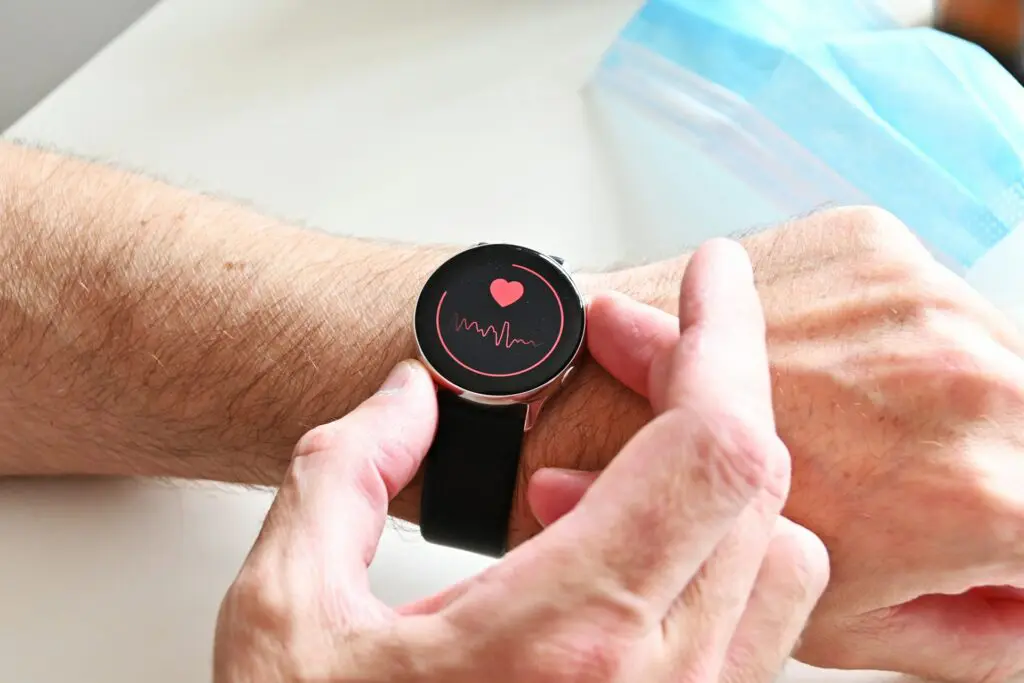If you’re working on improving your health, you’ve probably heard the term “heart rate variability training.” So, what exactly is heart rate variability (HRV)? At its core, HRV measures the variation in time between consecutive heartbeats.
This variation is controlled by your autonomic nervous system, which manages essential functions like heart rate, digestion, and respiratory rate. A higher HRV indicates a more adaptable and resilient system, capable of handling stress more effectively.

What is HRV Training? | Advantages of HRV Training | Starting Out | HRV Training Methods | Tracking Your Progress | Common Obstacles | Summary
What is HRV Training?
HRV training focuses on monitoring and increasing this heart rate variability to optimize your body’s response to different stressors. When you track your HRV, you get insights into how well your body is recovering from exercise, stress, and daily activities. This data can be a game-changer for your overall health, allowing you to tailor your fitness routine to your specific needs.
Incorporating HRV training into your regimen is beneficial for anyone looking to improve their physical and mental well-being. Plus, with the technology available today, measuring your HRV has never been easier. Many of the best fitness trackers and smartwatches offer HRV monitoring, making it accessible for everyone.
Advantages of HRV Training
When you start HRV training, you’re unlocking several health benefits:
Reduced Burnout
One of the key advantages is reducing burnout. By engaging in HRV training, you’re actively working on improving your resilience to stress. In fact, individuals with higher HRV levels are typically more resilient to stress and tend to have better cardiovascular fitness.
Improved Physical Performance
HRV training isn’t just about stress management; it also enhances physical performance. For instance, HRV-guided training, which adjusts exercise intensity based on HRV scores, has been shown to enhance running performance more effectively than pre-planned training schedules. This adaptability ensures that your training regimen is both effective and personalized.
Better Sleep
Additionally, HRV training can improve your sleep quality. By monitoring your HRV, you can identify patterns that affect your sleep and make adjustments to enhance rest. Quality sleep is crucial for recovery and overall well-being, making this a significant benefit.
Better Decision-Making
Moreover, HRV training supports better decision-making in your fitness routine. When you understand your HRV, you can tailor your workouts to match your body’s readiness, avoiding overtraining and minimizing the risk of injury. This leads to more consistent progress and sustainable fitness habits.
Beginning Your HRV Training Journey
1. Get the Right Gear
To kick off your HRV training journey, the first step is to get the best HRV monitor for you. Fitness trackers and smartwatches are popular choices, as many of them come with built-in HRV monitoring features. Accuracy is key, so choose a device known for precise measurements.

2. Regularly Monitor Your HRV
Once you have your device, you’ll need to establish a routine for measuring your HRV. The best time to take these readings is usually in the morning, right after you wake up. This gives you a baseline that’s unaffected by daily activities or stressors. The best hrv monitors will track your metrics automatically.
Start by taking daily measurements and logging your data. Initially, your goal is to establish a baseline, which will help you identify patterns and trends over time.
3. Learn the Lingo
Next, familiarize yourself with the app or software that accompanies your device. These platforms often provide insights and trends that help you understand your HRV readings. Take some time to explore these features and customize the settings to suit your preferences.
HRV Training: Evidence-Based Methods
Breathing Exercises
Controlled, deep breathing, such as diaphragmatic breathing, directly impacts HRV by promoting relaxation and stimulating the vagus nerve. This kind of breathing increases the variability between heartbeats.
Another technique is 4-7-8 breathing, which involves inhaling for four seconds, holding for seven, and exhaling for eight. This helps reduce anxiety, which can help stimulate the parasympathetic nervous system and boost heart rate variability.

Exercise
Regular exercise strengthens your heart and improves your nervous system’s control over heart rate. This helps your heart respond better to stress and daily activities. Physical activity also reduces inflammation and stress hormones, allowing your heart rhythm to vary more naturally between beats.
- Running/walking
- Yoga
- Pilates
Yoga specifically can lead to significant improvements in HRV by fostering a strong parasympathetic response. Be mindful not to overtrain, as this can temporarily decrease HRV.
Sleep Optimization
High-quality sleep is crucial for autonomic nervous system health and can positively affect HRV by improving vagal tone and resilience to stress.
Focus on consistent sleep and wake times, create a cool, dark sleeping environment, and aim for 7-9 hours of quality sleep per night.
Diet and Hydration
A balanced diet rich in nutrients that support nerve health can improve overall body function and stress response. Foods high in omega-3 fatty acids or supplements, for instance, are known to improve cardiovascular health and may positively influence HRV. Also:
- Stay well-hydrated throughout the day
- Reduce alcohol consumption, as it can negatively impact HRV
- Maintain balanced blood sugar by eating regular meals
- Consider reducing caffeine intake, especially later in the day
Meditation and Mindfulness
Meditation calms your nervous system, improves your parasympathetic response, and reduces stress hormones in your body. When you meditate regularly, your breathing becomes slower and more controlled, which trains your heart to adjust its rhythm more effectively.
Spending Time in Nature
Nature walks or time spent in green spaces can lower stress and improve mood, which in turn can enhance HRV. This is due to the calming effect nature has on the parasympathetic nervous system.
Try taking off your shoes and walking barefoot if safe to do so. Some people swear by grounding shoes to help connect themselves better with the earth.
Social Connections and Laughter
Positive social interactions and laughter can increase vagal tone and improve HRV by boosting emotional health and stress resilience.

Massage and Acupuncture
These therapeutic practices can activate the parasympathetic nervous system and may help improve HRV by reducing physical and emotional stress and enhancing relaxation. Read more about the benefits of acupuncture.
Tracking Your Progress and Making Changes
Keeping track of your HRV data is crucial for understanding your body’s reactions to different workouts and stressors. As you consistently monitor your HRV, you’ll start to see trends and patterns that can guide your fitness decisions. For example, if your HRV readings indicate you’re not recovering well, consider adding more rest days or incorporating stress-relief activities.
On the flip side, if your HRV scores are consistently high, it could be a sign that your body is ready for more challenging workouts. You can gradually increase the intensity or duration of your exercises to keep pushing your limits. The key is to remain flexible and responsive to what your HRV data is telling you.
Tackling Common Obstacles
How to Stay Motivated?
Embarking on any new fitness journey comes with its challenges, and HRV training is no exception. One common challenge is staying motivated. To keep your spirits high, consider partnering with a workout buddy or joining a fitness community or class where you can share tips and support each other. This also helps with accountability. Setting achievable short-term goals and celebrating your progress can also provide a much-needed boost.
What Do I Do If I Fall Off Track?
Another hurdle you might face is consistency. Life can get busy, making it easy to skip a workout or forget to track your HRV. Try to integrate your fitness routine into your daily schedule, setting aside specific times for exercise and relaxation practices. If you miss a day, let it go and start fresh the next day.
All of This HRV Data is Confusing
Understanding the data can also be tricky. HRV metrics might seem confusing at first, but many apps and devices offer user-friendly interfaces that break down the information for you. Take some time to familiarize yourself with the features and resources available to you. Don’t be afraid to reach out for help, whether it’s through online forums or customer support from your device manufacturer.
I’m Too Tired
Lastly, dealing with physical or mental fatigue can be discouraging. Listen to your body and don’t push yourself too hard. Incorporate rest days and stress-relief practices like meditation to help maintain balance. Remember, the goal is sustainable progress, so it’s important to be patient with yourself and make adjustments as needed.

HRV Training: Summary
HRV training can be a powerful tool in your wellness arsenal, offering benefits like stress reduction and improved fitness. By focusing on your heart rate variability, you’re taking a proactive approach to your health that can yield long-term results.
As you progress, continue to listen to your body and adjust your routine based on your HRV data. This adaptive approach helps you stay in tune with your needs and avoid overtraining. Continue to explore new methods and technologies to help keep your training engaging and effective.
Share your HRV training tips below! What tips and techniques did we miss that are must-have for HRV health?
More from Bananomad
- Never waste another minute with our guide to what to do on a long car ride by yourself. 38 creative ideas to pass the time in a car when bored.
- Bananomad walks you through a detailed RV maintenance checklist, including monthly, seasonal, and yearly tasks that will keep your rig running smoothly.
- Discover why food lovers choose Pigeon Forge, Tennessee as a hidden gem for culinary delights. There’s more to it than bbq.


Leave a Reply